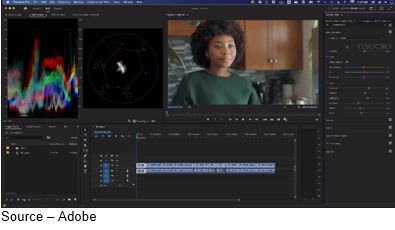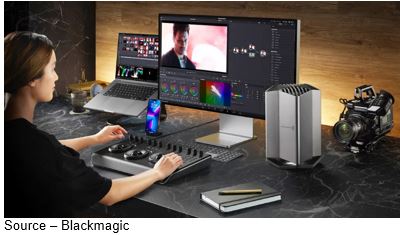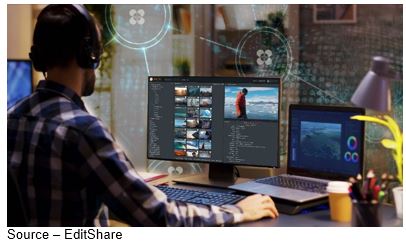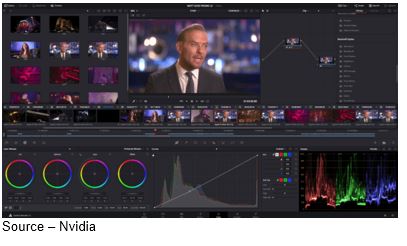Maybe it’s the fact that it’s been three years since folks could gather to see and talk about creative industry stuff. Maybe it’s because creators and deliverers want to discuss the important topics of the day – content security, working in the cloud, Netflix. There was a lot to cover at NAB and this one is on security, cloud work and production.

Attendance was about 50K folks – 50-60 percent of the last in-person event in 2019 but that isn’t bad; and with more than 350 companies on the floor and an information-packed program, it was a great show.
 “You are to face the world’s best. Brown and yellow, white and black, young and ardent as yourselves, fleet of foot and strong of limb, from every civilized nation on the face of the Earth. I have no doubt, that you will acquit yourselves honorably and with distinction. Good luck to you all.” Lord Birkenhead, “Chariots of Fire,” Enigma, 1982
“You are to face the world’s best. Brown and yellow, white and black, young and ardent as yourselves, fleet of foot and strong of limb, from every civilized nation on the face of the Earth. I have no doubt, that you will acquit yourselves honorably and with distinction. Good luck to you all.” Lord Birkenhead, “Chariots of Fire,” Enigma, 1982
The first thing we had to see was the town’s new permanent fixture that was guided by a filmmaking friend – Andrew Shulkind – the new MSG Sphere which could set the standard for immersive entertainment.
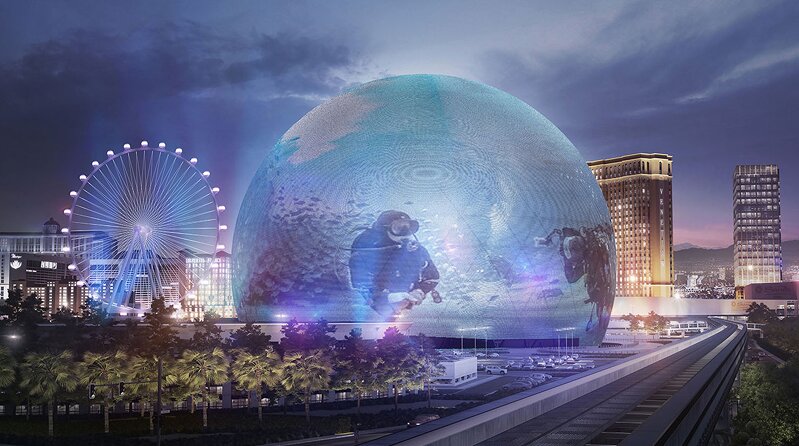 An exterior rendering of MSG Sphere at The Venetian. The state-of-the-art venue, which will be 366-feet tall and 516-feet wide. (The Madison Square Garden Company)
An exterior rendering of MSG Sphere at The Venetian. The state-of-the-art venue, which will be 366-feet tall and 516-feet wide. (The Madison Square Garden Company)
When he first showed us the plans, all we could think of was Mad Max Beyond Thunderdome but when you see the massive sphere – the largest spherical structure in the world, you can’t wait to experience the new level of immersive films and events creative minds will deliver without those dumb, bulky headsets. Without naming names, Andrew did say they were in deep discussions with leading Tinseltown studios and creators, so expect to see some breathtaking content at next year’s NAB. Think of it, being inside a Blackmagic Resolve, Amazon, EditShare or Nvidia RTX-powered workflow project.
Yeah, Tron up close and personal!
But the creative hot topics this year were the focus/refinement in content security from beginning to end and the streamlining, improvement and budget improvements that have been made in cloud workflow. It’s more than just a moral issue when it comes to movie/show piracy.
 No, It’s Not – Maybe, hopefully, the industry has reached a point where calling password swaps and pirate downloads aren’t a validation of how popular a film/show is. It’s illegal and it steals money from future video projects and stakeholders.
No, It’s Not – Maybe, hopefully, the industry has reached a point where calling password swaps and pirate downloads aren’t a validation of how popular a film/show is. It’s illegal and it steals money from future video projects and stakeholders.
It will cost the M&E industry more than $50 billion this year with more than 80% of the loss attributed to illegal – torrent – streaming services. Contrary to the pronouncements at CinemaCon – over at Caesar’s Palace – a theatrical window of any length (day/date, 17-20 days) doesn’t solve the problem…only robust/aggressive security from beginning to end is the solution. Windows only benefit the movie house owners.
It was so important that MESA’s (Media Entertainment Services Alliance) CDSA (Content Delivery & Security Association) held a full day of informational sessions on the first day of NAB. They covered global approaches for content protection and anti-piracy as well as some interesting approaches on how folks can recover revenue from piracy … sweet!
The film/content industry really didn’t think much about content security and project protection until 1996 when the first feature film, Windhorse, was shot, post produced digitally. Before that, you shot stuff on film, put it in cans, took it to folks who cut it, color-corrected it, added/enhanced sound, painstakingly tweaked the frames and cut it again. Anything that was left over was swept up and thrown in the trash.
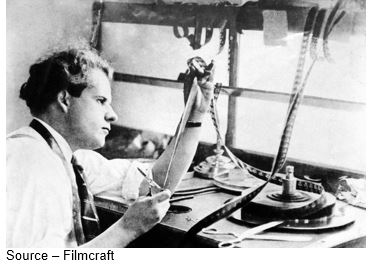 Glamour Days – Back when film was film the post production process was extremely manual and probably not a whole lot of fun. But content theft was much less.
Glamour Days – Back when film was film the post production process was extremely manual and probably not a whole lot of fun. But content theft was much less.
But now, everyone (except for a dwindling number of holdouts) uses Blackmagic, Arri, Red or even iPhones to shoot their stuff, often capturing 5-10 times the amount of content they will ever use. After all, SSDs (solid state devices) are cheap and can be used 3-4 times (could be used longer but no one wants to push their luck) before they’re thrown in the drawer or filed somewhere.
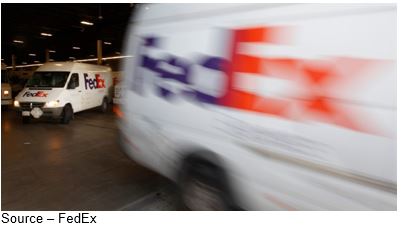 Moving Content – The best post production specialists decided where they wanted to live/work, which lead to projects being shipped cross town or halfway around the globe for them to work their magic. It all impacted the budget – time/financial.
Moving Content – The best post production specialists decided where they wanted to live/work, which lead to projects being shipped cross town or halfway around the globe for them to work their magic. It all impacted the budget – time/financial.
It was expensive and time-consuming but relatively safe. The studios, content distributors wanted the projects completed yesterday so, instead of moving files from post production station to post production station (sneaker net), the tool folks (Adobe, Avid, Frame.io, Blackmagic DaVinci, Lightworks, Autodesk, and others) moved their products to the cloud so postproduction specialists could work their magic no matter where they were located. Suddenly, loss and theft became a major problem throughout the food chain/ecosystem.
It’s one thing to lose a scene or segment in shipping because the DIT always has his/her backup(s). But if someone steals it while its going across the internet, you never know until it shows up on someone’s screen somewhere. An executive in the NAGRA booth said,
“We’re offering some of the most advanced solutions this year from the moment of ingest, throughout the production/post process and even for the delivery. While some of the companies on the show floor offer good solutions for various steps of the cycle, we really want to be – and are– best of breed across the spectrum.”
Booth people tend to say that; but in looking and understanding their various hardware/software solutions, they’re pretty darn good.
“We’ve delivering some of the best multi-DRM (digital rights management) solutions for indies, production/post facilities and theatrical/end consumer delivery,” the NAGRA executive continued, “and hopefully, in the near future maybe we’ll be able to offer something that will plug the weak point in the process.”
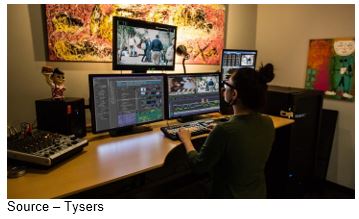 Security – Today, organizations are emphasizing content security from the time the project leaves the digital camera to the time when it hits the viewer’s screen; and for the most part it really works. The weak link is the person behind the keyboard.
Security – Today, organizations are emphasizing content security from the time the project leaves the digital camera to the time when it hits the viewer’s screen; and for the most part it really works. The weak link is the person behind the keyboard.
“System/process attack probes go on round the clock, round the calendar,” she continued. “We and a few of our competitors constantly beef up processes and procedures to ensure no content is lost while simultaneously not being an impediment to the production.
“The weak link,” she added, “is the person behind the keyboard who innocently responds to the phishing probe and ransomware/malware is introduced and content is stolen. Someday, we’ll have the solution … someday.”
The best cloud folks – AWS, IBM, Google, Microsoft (Azure) – have security offerings that creators, producers and deliverers should certainly consider but … In addition, the workflow folks – Adobe, Avid, DaVinci, Autodesk, etc. – offer some levels of security. However, we’re sorta partial to the people who focus 100% of their attention on keeping content safe every step of the way including encryption, conditional access and authentication, and zero trust.
 Market Grows – Production/post work is done around the globe producing valuable opportunities for content creators everywhere and producing/delivering a growing entertainment market.
Market Grows – Production/post work is done around the globe producing valuable opportunities for content creators everywhere and producing/delivering a growing entertainment market.
While there are some solid regulatory/industry standards and recommendations for content protection, products/services that cover all the bases without getting in the way of the production process are best. All of the products we visited at the show had their strengths/weaknesses, pros/cons and cheerleaders/naysayers; but even with fewer exhibitors this year, there was only so much time.
Besides, workflow/production tools are hotter, sexier. LED Video Walls weren’t on my gotta check this out list; but OMG, they are awesome the way they have changed the content industry so quickly.
 LED Walls – Green screens are rapidly disappearing in studios as producers/directors take advantage of enhanced creative opportunities with LED Video Walls. The advance has also had an impact on the travel/time budgets of projects since everything can be done in one location better and faster than ever before.
LED Walls – Green screens are rapidly disappearing in studios as producers/directors take advantage of enhanced creative opportunities with LED Video Walls. The advance has also had an impact on the travel/time budgets of projects since everything can be done in one location better and faster than ever before.
Sure, you’ve seen photos of projects being done like Mandalorian, work that is being done in Atlanta’s Tyler Perry, Blackhall, EUE Screen Gems, Toronto’s Pinewood, Cinespace and AstroLab as well leading studios around the globe and up close; they are awesome. The virtual production solution came just in time what with lockdowns and travel restrictions. The LED walls made up of hundreds of high-def displays that serve as interactive backdrops are a little like the old-fashioned green screen but much more sophisticated. (see RGB is Not Enough for Virtual Production and Macroblock Talks Up Virtual Production and MiniLED among many articles on this site about the topic – editor)
The good news is the prices are coming down as the number of producers/assemblers increase to the point where if a studio doesn’t have one … they’re not really a studio. But in our mind, the real magic/real work begins once the digital content leaves the camera and moves to the time/money budget-compressed postproduction process.
(I would disagree here with Andy. One of the key points about virtual sets is that it radically changes the workflow with much of the magic having to be done before camera capture, you can’t just ‘fix it in post’, unlike the traditional green-screen approach – editor)
 Post Funding – Thanks to more robust cloud services and cloud-based workflow, MAM and editing/post advances the M&E industry have taken nearly all of the production/post work online to save time and money.
Post Funding – Thanks to more robust cloud services and cloud-based workflow, MAM and editing/post advances the M&E industry have taken nearly all of the production/post work online to save time and money.
Development and refinement of cloud-enabled products from storage to post phases and processing made giant strides forward in the past three years–especially the remote production tools for editors, colorists, VFX, animation, audio/sound, dubbing/captions, mixing and other specialties. With the content in the cloud, and the best tools available globally, no one thinks twice about sending project work to people across town, across the country or halfway around the world. While there were several very good workflow/production products at the show we focused on the three solutions that provided frictionless security, compliance, seamless collaboration and workflow from anywhere – Adobe, Blackmagic DaVinci and EditShare.
Adobe
Adobe added Frame.io to its expansive production arsenal in the third quarter of last year and has done an outstanding job of integrating the online video review/collaboration platform for creatives. Users of Premiere Pro and After Effects can work seamlessly with all of their tools and Frame.io in the Creative Cloud, providing an end-to-end cloud-based video platform. It enables editors, post specialists and key stakeholders to collaborate to analyze, evaluate, adjust and approve work faster than we ever thought possible.
One of our longtime Adobe friends showed us how creatives can work on five different projects concurrently. He noted that soon, two users will be able to collaborate on a project in real time to reduce production lag time and minimize rework.
DaVinci
Ever since Blackmagic purchased DaVinci Systems back in 2009, it’s been making it more feature-rich, more capable, more user friendly and more affordable for creatives, just like their cameras. DaVinci Resolve 18 is a major cloud collaboration update that allows multiple editors, colorists, VFS artists and audio engineers to simultaneously work on the same project, same timeline … from anywhere.
The new FX AI tools are powered by DaVinci’s Neural Engine. It’s a real timesaver for editors and features a load of additions that handle FlexBus conversion, accelerated GPU paint and a proxy generator that automatically creates linked proxies for faster editing as well as a roster of Resolve FX additions. Sometimes we think CEO Grant Petty really might make good on his goal of making Blackmagic the go-to source video storytellers.
EditShare
EditShare started its move to the cloud with Flex cloud solutions a couple of years ago and now all of their core capabilities – openness, interoperability and scale are available and affordable to creatives in the cloud. In its simplest form, EditShare Flex provides robust MAM (media asset management), high-performance, software-defined storage and AWS cloud-based virtual workstations. Flex Cloud Edit+ adds accelerated file-transfer capabilities, comprehensive workstation management and more, all integrated into a single EditShare environment.
Nvidia
We simply ran out of safe production time (pun intended) because we wanted to spend time at Nvidia’s booth. We wanted to find out more on the latest Nvidia RTX GPU that is being used by all of the best creative product solutions (Blackmagic, Avid, Autodesk, Adobe) to quickly, efficiently handle today’s advanced 8K video production.
We did get a peek at it during Nvidia’s recent GTC (Graphic Technology Conference). We saw how Epic Games, Unity’s latest, give creators access to RTX-powered real-time engine ray tracing.
It’s so fast, so powerful that workstations don’t even build up a sweat.
It’s really exciting to see how the M&E industry’s tools of the trade producers stepped up to meet the challenges and opportunities of the last few years, helping the industry condense five – seven years of advancement into just a few and do it right. They’ve done it so well, so fast we sometimes feel like Harold M. Abrahams in Chariots of Fire when he said, “I’m forever in pursuit and I don’t even know what I am chasing.” (AM)
# # #
Andy Marken – [email protected] – is an author of more than 700 articles on management, marketing, communications, industry trends in media & entertainment, consumer electronics, software and applications. Internationally recognized marketing/communications consultant with a broad range of technical and industry expertise especially in storage, storage management and film/video production fields. Extended range of relationships with business, industry trade press, online media and industry analysts/consultants.
This article will not count towards your two free recent Display Daily articles if you do not have a paid subscription.


